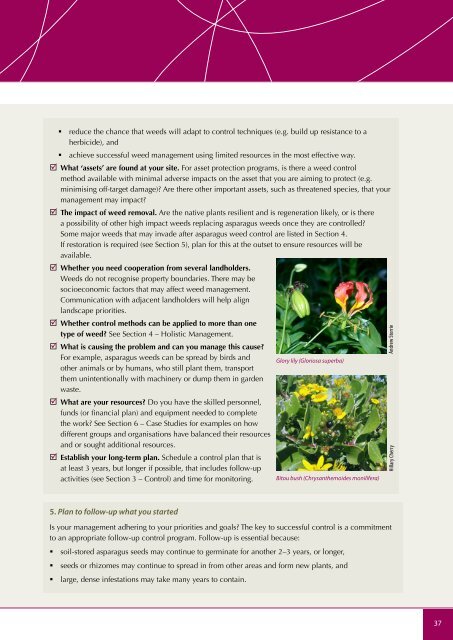Asparagus weeds - Weeds Australia
Asparagus weeds - Weeds Australia
Asparagus weeds - Weeds Australia
- No tags were found...
You also want an ePaper? Increase the reach of your titles
YUMPU automatically turns print PDFs into web optimized ePapers that Google loves.
• reduce the chance that <strong>weeds</strong> will adapt to control techniques (e.g. build up resistance to aherbicide), and• achieve successful weed management using limited resources in the most effective way. What ‘assets’ are found at your site. For asset protection programs, is there a weed controlmethod available with minimal adverse impacts on the asset that you are aiming to protect (e.g.minimising off-target damage)? Are there other important assets, such as threatened species, that yourmanagement may impact? The impact of weed removal. Are the native plants resilient and is regeneration likely, or is therea possibility of other high impact <strong>weeds</strong> replacing asparagus <strong>weeds</strong> once they are controlled?Some major <strong>weeds</strong> that may invade after asparagus weed control are listed in Section 4.If restoration is required (see Section 5), plan for this at the outset to ensure resources will beavailable. Whether you need cooperation from several landholders.<strong>Weeds</strong> do not recognise property boundaries. There may besocioeconomic factors that may affect weed management.Communication with adjacent landholders will help alignlandscape priorities. Whether control methods can be applied to more than onetype of weed? See Section 4 – Holistic Management. What is causing the problem and can you manage this cause?For example, asparagus <strong>weeds</strong> can be spread by birds andGlory lily (Gloriosa superba)other animals or by humans, who still plant them, transportthem unintentionally with machinery or dump them in gardenwaste. What are your resources? Do you have the skilled personnel,funds (or financial plan) and equipment needed to completethe work? See Section 6 – Case Studies for examples on howdifferent groups and organisations have balanced their resourcesand or sought additional resources. Establish your long-term plan. Schedule a control plan that isat least 3 years, but longer if possible, that includes follow-upactivities (see Section 3 – Control) and time for monitoring.Bitou bush (Chrysanthemoides monilifera)Andrew StorrieHillary Cherry5. Plan to follow-up what you startedIs your management adhering to your priorities and goals? The key to successful control is a commitmentto an appropriate follow-up control program. Follow-up is essential because:• soil-stored asparagus seeds may continue to germinate for another 2–3 years, or longer,• seeds or rhizomes may continue to spread in from other areas and form new plants, and• large, dense infestations may take many years to contain.37
















